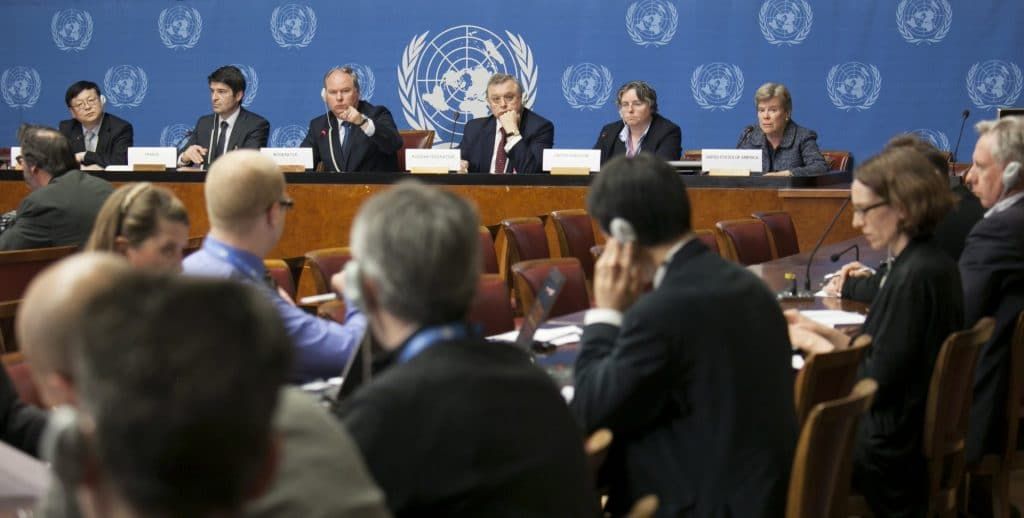Nuclear arms control: Still necessary, but more difficult than ever
By Stephen J. Cimbala, Lawrence J. Korb | April 5, 2022
 P5 Press Conference at the United Nations. April 2013. Credit: U.S. Mission Geneva / Eric Bridiers. Accessed via Flickr. https://www.flickr.com/photos/us-mission/8663813428 CC BY-ND 2.0.
P5 Press Conference at the United Nations. April 2013. Credit: U.S. Mission Geneva / Eric Bridiers. Accessed via Flickr. https://www.flickr.com/photos/us-mission/8663813428 CC BY-ND 2.0.
Russia’s war against Ukraine has worsened an already deteriorating political relationship with the United States and NATO. The fraught atmosphere between Washington and Moscow also threatened to affect the issue of nuclear arms control. The New Strategic Arms Reduction Treaty (New START), which Russia and the United States extended for five years in 2021, is the last remaining nuclear arms control agreement between the two powers. If New START is thrown overboard or dies of inattention, there would be no remaining treaty to constrain the advent of a second nuclear arms race, one potentially more dangerous than US–Soviet competition during the Cold War.[1]
Some question whether arms control is even possible in the new world order that was already taking shape before Russia’s invasion of Ukraine. Challenges to nuclear arms control come from shifts in global political alignments, new technologies, and domestic pressures for nuclear modernization.[2] During the Cold War, the arms race was largely dominated by American and Soviet superpowers. Eventually, it became clear to both sides that there was no “last move” in strategy, or any technology breakthrough, that would provide nuclear superiority relative to the opponent. Mutual deterrence based on assured retaliation was accepted as a matter of fact. And although the Cold War witnessed some close calls in terms of crisis management, both the Americans and the Soviets learned that competition in nuclear risk-taking had to operate under tacit and explicit rules of the road to avoid an outbreak of nuclear war based on misperceptions of enemy intent, technology failures, or miscalculated escalation.
This “nuclear learning” during the Cold War will require a reboot for adaptation to the so-called “third nuclear age” of the early-to-mid 21st century. In terms of nuclear weapons deployed on intercontinental launchers, there are now three major players. China’s rise as an aspiring peer competitor with the United States and Russia changes the game of deterrence and defense against nuclear attack.[3] Although China currently deploys only several hundred warheads on long-range launchers, this number is likely to grow rapidly as the People’s Republic fleshes out its triad of land-based missiles, bombers, and submarine-launched ballistic missiles.[4]
Technology has also complicated the challenge of maintaining nuclear deterrence stability, in several ways. First, hypersonic weapons can travel within the atmosphere at supersonic speeds and (potentially) evade antimissile defenses. Their speed reduces the time between detection of enemy missile launch and the arrival of enemy weapons at their targets.[5] Hypersonic weapons increase first-strike vulnerability for some components of the US strategic retaliatory forces: silo-based intercontinental ballistic missiles (ICBMs) and unalerted bombers. Leaders may feel more pressure to launch potentially vulnerable missile forces “on warning” rather than lose them.
Second, there is the growing interest in missile defenses. Although no missile-defense systems will invalidate the effectiveness of large-scale nuclear attacks over the near term, promising technologies may create partially effective systems for national defense and more preclusive systems for theater or local protection against missile strikes.[6] These new technologies include drone swarms, ground- or space-based lasers or beams, unmanned aerial vehicles with air-to-ground strike weapons, and cyber “left of launch” techniques for aborting or distorting enemy launch and control systems.
Third, space has emerged as a medium for competitive strategy and possible conflict. Creation of the US Space Force recognized space as a conflict domain along with land, sea, air, and cyber.[7] The United States depends upon space for reconnaissance, navigation, targeting, early warning of missile attack, and other missions. Destruction or interference with American space assets could delay or forestall military operations otherwise global in reach and timely in effect.[8] In addition, space-based missile defenses will have to be protected from “defense suppression” of their satellites and-or ground links.
Deterring attacks against space-based defenses may require deployment of specially tasked defensive satellites maintaining keep-out zones around the defenses. The problem is not hypothetical. Existing US satellites in various orbits are already being tracked in real time by Russian and Chinese satellites in rendezvous-and-proximity operations.[9] Technically, such operations may be as innocent as satellite repairs, but the same technology would enable rendezvous-and-proximity satellites to disable or destroy unfriendly satellites.[10] In sum, the relationship between space-based defenses and deterrence is at least three sided: space-based components of a ballistic missile defense architecture must be survivable; defense suppression attacks against space-based missile defense must be deterred by denial (deterrence by punishment after the fact is too late); and deterrence of attacks in space requires resilient command, control, and communications that degrade gracefully, if at all, in the face of enemy initiatives.
A fourth aspect of the 21st century new world order is information and cyberwar. Today, cyber is the enabler for conflict in all other domains.[11] Digitally empowered US forces maintain superiority across land, sea, air, and space domains. It follows that cyber defense and offense must keep up with pacing threats.[12] But there’s a problem: The United States has more apparent success in offensive than defensive cyberwar, partly because our democratic political system and dynamic market-based economy cannot be protected only by government efforts. The private sector must cooperate with the US government to quickly detect threats to cybersecurity and to apply appropriate denial of access or defeat of malware intrusions.
Today, Russia and China view cyberwar as a cost-effective way to steal American technology and intellectual property. Russian war planning includes options for the use of strategic cyber operations against military and other targets. The use of information warfare and cyberattacks is also prominent in China’s emphasis on “unrestricted warfare.” Cyber operations come in two varieties: attacks on computers, networks, and their supporting infrastructure and information operations, more specific to the war of ideas and images. In its war against Ukraine in 2022, for example, Russian information operations have fallen far short of their mark. Russian disinformation and deception operations were clumsy, transparent, and ultimately ineffective. They lost the information war within a week of fighting.
A fifth challenge for nuclear arms control in a 21st-century context lies in the control of nuclear proliferation. How do we convince any existing nuclear weapons state to give up its nuclear arsenal if experience teaches that nukes are the guarantor against imposed regime change? It would not be unreasonable for some states feeling threatened by nuclear-armed or nuclear-aspiring neighbors to consider developing their own arsenals.
Succeeding in the 21st-century nuclear arms control era must begin with a willingness on the part of the leaders in Russia, the United States, and China—and later, other nuclear weapons states—to establish working groups of experts to explore the new world of nuclear deterrence and arms control. The desired outcome would be a series of policy papers addressing issues such as:
- How do different countries understand the concept of arms control, given new technology and rising state actors?
- How much is enough, in the way of nuclear weapons and delivery systems, for each state to meet its basic security needs?
- How will the evolution of space and cyber as conflict domains influence each state’s definition of its minimum-security requirements?
- What is each state’s view of the relationship between offensive strike weapons and missile and aircraft defenses, relative to nuclear strategic stability and deterrence?
- And how will advanced technologies for conventional warfare change ideas about conventional and nuclear deterrence?
The challenges facing future nuclear arms control are daunting—but not impossible—to meet.
[1] For background, see: Lawrence J. Korb, “Why it could (but shouldn’t) be the end of the arms control era,” Bulletin of the Atomic Scientists, October 23, 2018, https://the bulletin.org/2018/10/why-it-could-but-shouldnt-be-the-end-of-the-arms-control-era.html. See also: Stephen J. Cimbala, The United States, Russia and Nuclear Peace (New York: Palgrave-Macmillan/Springer, 2020).
[2] For example, see: Patrick Tucker, “Why New Technology Is Making Nuclear Arms Control Harder,” Defense One, March 14, 2022, https://www.defenseone.com/policy/2022/03/why-new-technology-making-nuclear-arms-control-harder/363135/. See also: Steven Pifer, “With US-Russian arms control treaties on shaky ground, the future is worrying,” Brookings, April 25, 2019, in Johnson’s Russia List 2019 – #72 – April 29, 2019, [email protected]
[3] William J. Broad and David E. Sanger, “A 2nd New Nuclear Missile Base for China, and Many Questions About Strategy,” New York Times, July 6, 2021, https://www.nytimes.com/2021/07/26/us/politics/china-nuclear-weapons.html
[4] James M. Smith and Paul J. Bolt, eds. China’s Strategic Arsenal: Worldview, Doctrine, and Systems. Washington, D.C.: Georgetown University Press, 2021. See also: Defense Intelligence Agency. China: Military Power – Modernizing a Force to Fight and Win. Washington, D.C. U.S. Defense Intelligence Agency, 2019, www.dia.mil.
[5] Ian Williams, Adapting to the Hypersonic Era (Washington, D.C. Center for Strategic and International Studies, (November 2020), 3, https://defense360.csis.org/adapting-to-the-hypersonic-era/
[6] Michaela Dodge, “Missile Defense Reckoning Is Coming: Will the United States Choose to be Vulnerable to All Long-Range Missiles?” Fairfax, Va.: National Institute for Public Policy, August 20, 2020, <www.nipp.org>
Missile Defense Project, “Ground-based Midcourse Defense (GMD) System,” (Washington, D.C.: Center for Strategic and International Studies, 2021, https://missilethreat.csis.org/system/gmd/. Skepticism is expressed in: John Mecklin “Why Star Wars should remain a cinematic fantasy,” Bulletin of the Atomic Scientists, no. 4 (2019, pp. 135-136, https://thebulletin.org/2019/06/why-should-remain-a-cinematic-fantasy/
[7] U.S. Department of Defense, U.S. Space Defense Strategy, Summary. Washington, D.C. U.S. Department of Defense, June 2020. https://media.defense.gov/2020/Jun/17/2002317391/-1/-1/1/2020_DEFENSE_SPACE_STRATEGY_SUMMARY.PDF
[8] James Clay Moltz, “The Changing Dynamics of Twenty-First-Century Space Power,” Strategic Studies Quarterly, no. 1 (Spring 2019), pp. 66-94.
[9]Marissa Martin, Kaila Pfrang and Brian Weeden. Chinese Military and Intelligence Rendezvous and Proximity Operations. Secure World Foundation, April 2021, <www.swfound.org>
[10]Lawrence J. Korb, “The focus of US military efforts in outer space should be…arms control,” Bulletin of the Atomic Scientists, no. 4 (2019), pp. 148-150, DOI: 10.1080/00963402.2019.1628471
[11] See: P.W. Singer and Allan Friedman, Cybersecurity and Cyberwar: What Everyone Needs to Know. Oxford: Oxford University Press, 2014,and Martin C. Libicki. Cyberdeterrence and Cyberwar. Santa Monica, Calif.: RAND Corporation, 2009.
[12] Catherine A.Theohary, “Defense Primer: Cyberspace Operations,” Washington, D.C. Congressional Research Service, December 18, 2018, https://crsreports.congress.gov
Together, we make the world safer.
The Bulletin elevates expert voices above the noise. But as an independent nonprofit organization, our operations depend on the support of readers like you. Help us continue to deliver quality journalism that holds leaders accountable. Your support of our work at any level is important. In return, we promise our coverage will be understandable, influential, vigilant, solution-oriented, and fair-minded. Together we can make a difference.
Keywords: New START, Russia, Ukraine, United States, arms control, nuclear risk, nuclear weapons
Topics: Analysis, Opinion
















